One of the most beautiful types of orchids is considered to be the Vanda orchid. This beautiful flower has over 50 varieties. As a result of crossing, chic flowers of various colors appeared.
For a long time it was believed that Vanda is absolutely not suitable for home cultivation. And although flower growers managed to tame a beautiful plant, the Vanda orchid is nevertheless quite capricious in growing.
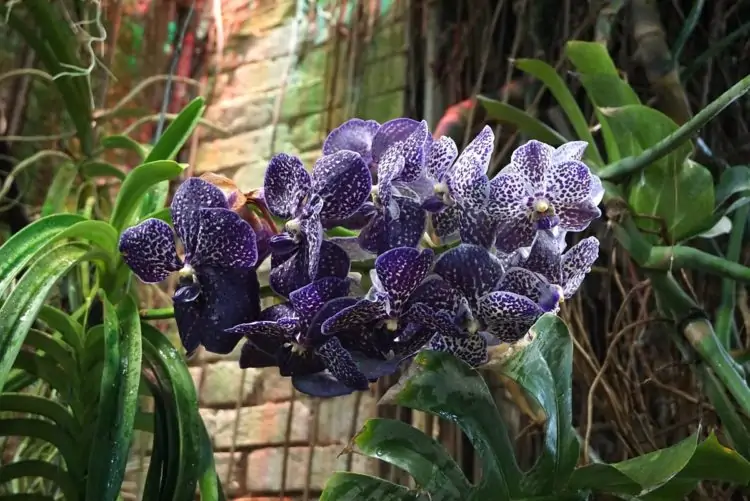
Vanda Orchid Detailed description and photo
The Latin name Vanda, comes from the Sanskrit Vanda, translated as “whisper of the wind” . Vanda’s colorful palette has collected the following colors: Red, white, yellow, blue orchid, pink, orange, purple. And the petals of some varieties look very elegant due to bright inclusions or a mesh pattern.
Orchids are distinguished by their lifestyle:
- epiphytes – growing on other plants;
- lithophytes – growing on stones;
- ground views.
The Vanda orchid can be epiphytic, lithophytic, and terrestrial . Most often found epiphytic.
Vanda is a rather large plant – in nature, the stem can reach 3 meters, and at home it grows on average up to 1 meter. The orchid does not grow in breadth.
The roots are powerful aerial, do not need soil and can easily tolerate direct sunlight.
The leaves are also quite powerful and large – belt-like or cylindrical, densely cover the stem, alternately growing up, while the lower leaves dry out. The number of leaves can reach several tens.
Peduncles are long – straight or inclined. The size of the peduncle depends on the variety, usually it is 30-50 cm . It is formed from the base of the last formed leaf. One plant can start up several flower stalks, on which from 2 to 15 buds are located.
The diameter of the flower ranges from 4 to 10 cm, and some varieties even reach 15 cm bud size.
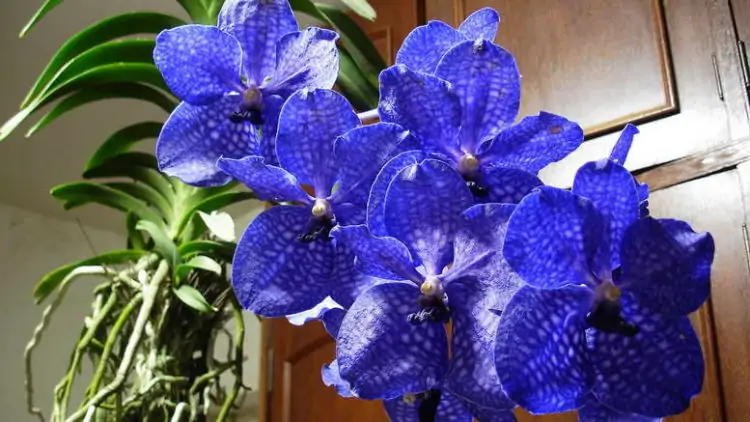
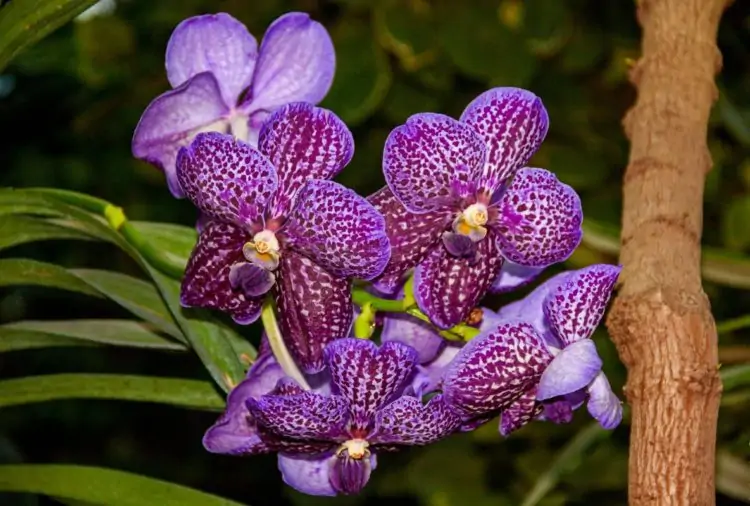
Vanda Orchid History of occurrence
Vanda was first discovered in Southwest Asia . The English scientist William Jones, who studied the nature of Asia, officially registered the name Vanda in 1795. And he named this wonderful flower in honor of the Polish princess Vanda. In those days, they thought so … In fact, the name of the flower was given back in India, the Indians called the tropical beauty “whisper of the wind.”
Vanda Orchid Distinctive features
- The Vanda orchid has a long stem, unlike the Phalaenopsis, which has a short stem.
- The number of leaves, unlike many other representatives, reaches several tens.
- Vanda does not form pseudobulbs, unlike dendrobiums.
Reference. A pseudobulb is a false bulb that forms next to the stem and serves to store water and nutrients, as well as for gas exchange.
types of vanda orchids
The most popular types of tropical beauty are presented below.
Rothschild (Vanda rothschildiana)
This is a hybrid of Sandera and Blue , which will be discussed later. This specimen belongs to epiphytes, the leaves are belt-shaped, the flowers are small in size – up to 5 cm. In its palette it has all shades of blue and blue. Blooms from October to January, May, June.
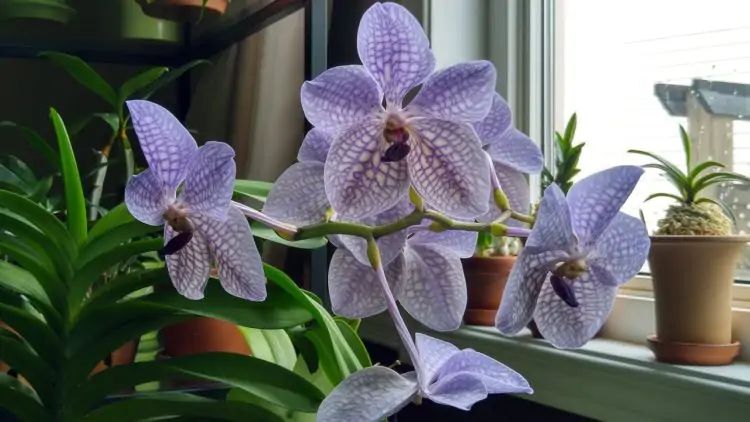
Vanda Rothschild is quite unpretentious, it is resistant to low temperatures, can withstand up to +10.
Check out Renanthera Kalsom (Red Dragon) Orchid.
Waling Waling Orchid (Vanda sanderiana)
It is rarely found in nature and is valued for its interesting color and beautiful long leaves reaching 40 cm. The size of the buds is 15 cm, up to 10 pieces can be located on a straight peduncle.
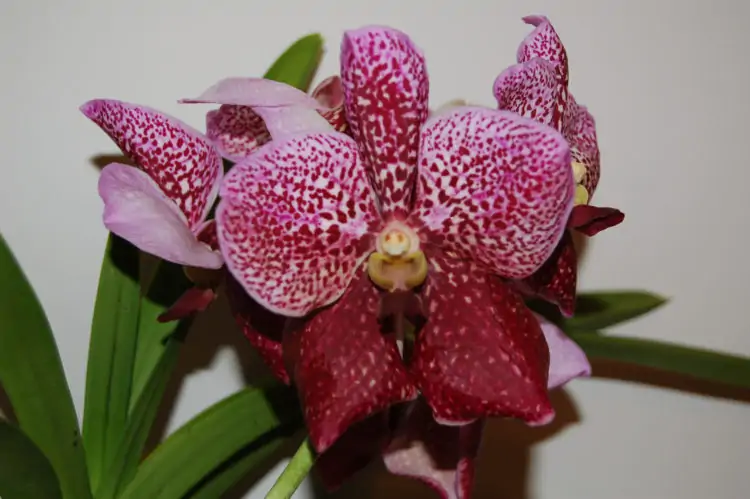
Distinctive features of the species are a double lip without a spur, as well as multi-colored petals and sepals with a variety of patterns of dots and strokes.
blue orchid (Vanda coerulea)
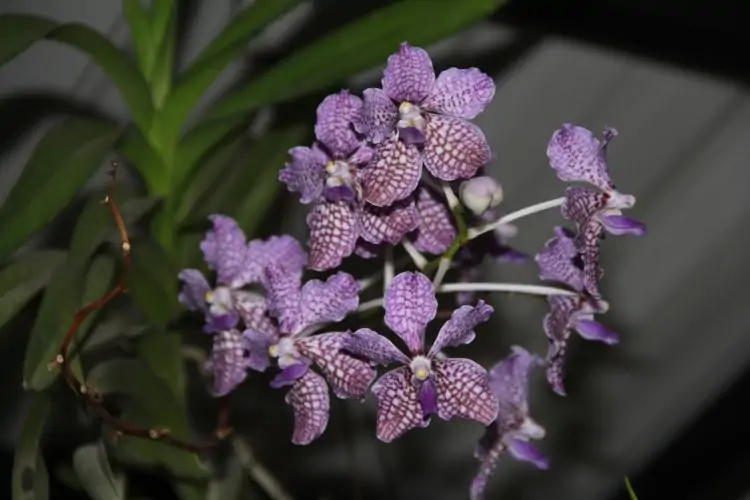
Up to 1 meter in height, the Blue Vanda also stands out with a developed root system. The leaves are dense, with jagged edges, reach 25 cm. The color is delicate lavender, the petals have a mesh pattern , and the leaves are belt-like. On one peduncle, 6-15 flowers are formed with a diameter of up to 10 cm. It blooms from September to October.
Vanda tricolor
It got its name for its unusual color: white and cream shades are basic and spots of burgundy color. The central lobe of the lip is pink or purple. Another interesting point: the edges of the tricolor are wavy. Grows up to 2 meters. The stem is straight, the leaves are belt-like, up to 40 cm long.
On the peduncle 7-10 flowers 7 cm in transverse dimension are formed. Petals are tear-shaped. Blooms from October to January, as well as May, June.
Vanda teres (Papilionanthe teres)
A giant orchid reaching 2.5 meters in height . The stem has many branches. The leaves are cylindrical, densely spaced along the entire length of the stem, reaching 20 cm. On one peduncle, from 3 to 6 buds fit, the flower is 10 cm in diameter. The buds are pink, with yellowish petals on the sides and a purple lip with dark speckles.
vanda orchids Medicinal properties
In folk medicine, the plant is used as a tonic and pain reliever.
vanda orchids Flowering: when and how does it happen?
With proper care, Vanda can bloom at any time of the year , as it does not have a natural dormant period. It may well bloom several times a year, with careful care and the proper level of lighting. Duration from 2 weeks to 1.5 months.
Sometimes the peduncle gives repeated flowering, so do not rush to cut off the faded peduncle. The fruits of just blossoming flowers look small and faded, as they grow, the sizes increase, and the buds are poured with a bright color.
vanda orchids What should be the soil?
The soil for planting Vanda should consist of charcoal, river sand and pine bark in equal parts. Moss should be laid on top.
vanda Growing methods
There are several ways to contain Vanda:
- Pot. The pot should be transparent with holes in the bottom and side walls. Suitable for young immature plants. It is necessary to lay the plant in a pot and fill it with a ready-made substrate.
- Glass vase . Here the soil is not needed, it is important to simply add water to the bottom of the vase. A glass vase looks, of course, very impressive, but this is not the most suitable environment for an orchid. After all, air circulates poorly in a vase.
- Hanging basket . The best conditions for growing orchids are in a hanging vase. Here the roots hang freely and the flower requires only spraying.
vanda orchids care at home
Temperature
This type of plant is very picky about temperature. To create comfortable conditions for Vanda, it is necessary to observe the temperature: during the day up to +30 °С, and at night not lower than +16 °С. In the spring-summer period: from +18 °С to +30 °С. In the autumn-winter period: from +16 °С to +26 °С
It is important to understand that a tropical beauty needs a temperature difference, the difference between day and night is from 10 ° C. This approach will ensure excellent flowering.
Lighting
Lighting is a necessary condition for the growth and flowering of orchids. But it is important to avoid direct sunlight, creating diffused light. The daily norm of light for Vanda is 12 hours. In winter, it is recommended to connect a phytolamp to the care.
Watering
General watering recommendations :
- In summer every day or every other day.
- In winter 3-4 times a week.
- Don’t forget to spray.
top dressing
Mineral fertilizers are suitable for feeding orchids, but it is important to halve the recommended concentration. Fertilize once a month by spraying the roots. Young plants fertilize 2 times a month.
pruning
Pruning is carried out after the end of flowering . And it is needed to regulate growth and more rapidly form a new shoot. Be sure to disinfect the secateurs, and process the sections.
Transfer
Orchid Vanda does not like transplants, only in extreme cases, namely:
- the substrate has hardened, which prevents air from flowing to the roots;
- the roots are deeply buried in the ground, which also prevents the penetration of air;
- soil depletion;
- root rot;
- Soil pollution.
When transplanting, inspect the roots, remove dry or rotten parts. Gently straighten the roots and seat in a container, cover with soil and moss.
Care during the flowering period
During flowering, you must carefully observe the mode of temperature, lighting and watering . Be sure to spray the plant.
During the flowering period, the orchid needs regular feeding and a high level of humidity.
What to do if it does not bloom?
If Vanda does not bloom, most likely not all indicators are met. To give yourself joy in the form of blossoming buds, reconsider your care. Follow all recommendations for temperature, lighting, watering, and inspect your plant for pests.
vanda orchids Propagation
Vanda propagates by cuttings or children.
babes
An adult plant forms shoots, which subsequently acquire their own root system . When the roots have grown, the baby is ready for separation.
- A young plant should be placed in a moist substrate
- Cover with a plastic jar or build another version of the mini-greenhouse.
- Spray the shoot as needed.
- The place should be warm and bright, but it is important not to allow direct sunlight.
cuttings
Propagation by cuttings is used when an adult plant begins to lose its appearance, shedding leaves.
- A stalk is cut from the top of the stem when it has 3 roots.
- The cut part must be treated with any growth stimulant for plants.
- And plant a cutting just like a baby.
vanda orchids Diseases and pests
The most common cause of plant disease is a fungal infection, such as Fusarium . It can be recognized by the dark spots at the base of the leaves. Method of treatment: treat with foundationazole.
There is another common disease that affects Vanda bacterial rot. To combat this disease, you will have to resort to antibiotics. Take 1 gram of tetracycline and dissolve in 1 liter of water. Water the plant with this solution once a week.
How to Prevent vanda orchids from problems?
- Avoid lack of lighting.
- Create conditions for rest in the winter. It is in winter that the dormant phase begins.
- Regularly remove dead roots and yellowed leaves.
Breeders gave us the opportunity to grow such a stunning flower at home. And although the maintenance of an orchid is always accompanied by difficulties, you should not give up! Adhering to all the recommendations, it is quite possible to grow a royal plant at home.